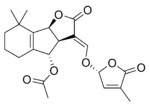Strigolactone

Strigolactones are plant hormones that stimulate the branching and growth of symbiotic arbuscular mycorrhizal fungi, increasing the probability of contact and establishment of a symbiotic association between the plant and fungus.[1][2] Strigolactones also inhibit plant shoot branching,[3][4] and trigger germination of parasitic plant seeds (for example Striga, from which they gained their name).[5] Strigolactones are carotenoid-derived and contain a labile ether bond that is easily hydrolyzed in the rhizosphere, meaning that there is a large concentration gradient between areas near the root and those further away. In 2009, strigolactone biosynthesis was found to be DWARF27-dependent.[6]
Naming
Strigolactones were first discovered in Striga lutea (witchweed), a parasitic weed that lacks the ability to photosynthesize. Such plants use Strigolactones exuded from the roots of host plants as a cue for germination. Such mechanism enables them to germinate close to a suitable host.[7]
Chemistry
Strigolactones are terpenoid lactones and are derived from carotenoids.
-Strigol_chemical_structure.png) |
 |
| (+)-Strigol | (+)-Strigyl acetate |
 |
 |
| (+)-Orobanchol | (+)-Orobanchyl acetate |
 |
 |
| (+)-5-Deoxystrigol | Sorgolactone |
See also
References
- ↑ Akiyama K, Matsuzaki K and Hayashi H (2005). "Plant sesquiterpenes induce
hyphal branching in arbuscular mycorrhizal fungi". Nature 435: 824–827. Bibcode:2005Natur.435..824A. doi:10.1038/nature03608. PMID 15944706. line feed character in
|title=at position 29 (help) - ↑ López-Ráez JA, Matusova R, Cardoso C, Jamil M, Charnikhova T, Kohlen W, Ruyter-Spira C, Verstappen F, Bouwmeester H (May 2009). "Strigolactones: ecological significance and use as a target for parasitic plant control". Pest Manag Sci. 65 (5): 471–7. doi:10.1002/ps.1692. PMID 19115242.
- ↑ Gomez-Roldan V, Fermas S, Brewer PB, Puech-Pagès V, Dun EA, Pillot JP, Letisse F, Matusova R, Danoun S, Portais JC, Bouwmeester H, Bécard G, Beveridge CA, Rameau C, Rochange SF (2008). "Strigolactone inhibition of shoot branching". Nature 455 (7210): 180–194. Bibcode:2008Natur.455..189G. doi:10.1038/nature07271. PMID 18690209.
- ↑ Umehara M, Hanada A, Yoshida S, Akiyama K, Arite T, Takeda-Kamiya N, Magome H, Kamiya Y, Shirasu K, Yoneyama K, Kyozuka J, Yamaguchi S (2008). "Inhibition of shoot branching by new terpenoid plant hormones". Nature 455 (7210): 195–200. Bibcode:2008Natur.455..195U. doi:10.1038/nature07272. PMID 18690207.
- ↑ Kohki Akiyama, Hideo Hayashi (2006). "Strigolactones: Chemical Signals for Fungal Symbionts and Parasitic Weeds in Plant Roots". Annals of Botany 97 (6): 925–931. doi:10.1093/aob/mcl063. PMC 2803390. PMID 16574693.
- ↑ Lin, H.; Wang, R.; Qian, Q.; Yan, M.; Meng, X.; Fu, Z.; Yan, C.; Jiang, B.; Su, Z.; Li, J.; Wang, Y. (26 May 2009). "DWARF27, an Iron-Containing Protein Required for the Biosynthesis of Strigolactones, Regulates Rice Tiller Bud Outgrowth". THE PLANT CELL ONLINE 21 (5): 1512–1525. doi:10.1105/tpc.109.065987. PMID 19470589.
- ↑ "Strigolactones and the control of plant development: Lessons from shoot branching". Plant Journal. doi:10.1111/tpj.12488.